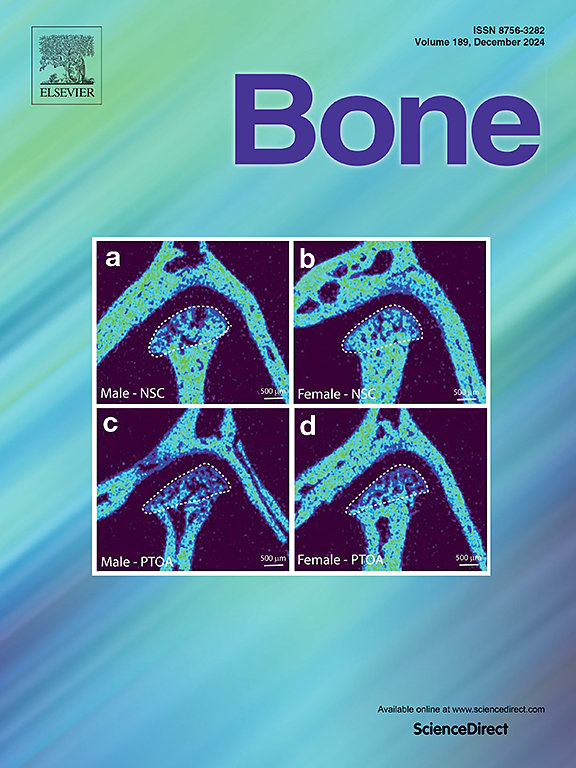Automatic phantom-less calibration of routine CT scans for the evaluation of osteoporosis and hip fracture risk
IF 3.5
2区 医学
Q2 ENDOCRINOLOGY & METABOLISM
引用次数: 0
Abstract
Background/Purpose.
The diagnosis of osteoporosis remains a paramount concern for orthopedic surgeons worldwide. We aim to (1) evaluate the efficacy of automatic phantom-less quantitative computed tomography (PL-QCT) in diagnosing osteoporosis and (2) investigate its clinical value in predicting hip fracture risk.
Methods
A cohort of 705 patients was included in the study. Hip CT scans from 310 patients and spinal CT scans from 315 patients were analyzed using automatic PL-QCT. The consistency of bone mineral density (BMD) measurement obtained by dual-energy X-ray absorptiometry (DXA), phantom-based QCT (PB-QCT), and automatic PL-QCT was examined through linear regression analysis and Bland-Altman plots. The ability of automatic PL-QCT to predict osteoporosis and hip fracture risk was assessed using ROC analysis.
Results
Linear regression and Bland-Altman plots demonstrated a high level of agreement between BMD measurements from PL-QCT and those from hip DXA and lumbar PB-QCT. The AUC values for PL-QCT and PB-QCT in diagnosing osteoporosis were 0.903 (95 % CI 0.852–0.955) and 0.900 (95 % CI 0.847–0.953). The AUC values for predicting hip fracture risk, based on femoral neck BMD measured by PL-QCT and DXA, were 0.869 (95 % CI 0.823–0.915) and 0.831(95 % CI 0.778–0.885), respectively. When the femoral neck BMD was combined with the percentage of inter-muscular adipose tissue area, the AUC increased to 0.929 (95 % CI 0.897–0.961).
Conclusion
Automatic PL-QCT has shown superior performance in predicting hip fracture risk compared to DXA. Furthermore, the novel PL-QCT demonstrates comparable predictive efficacy to that of PB-QCT, suggesting its potential as a valuable tool in clinical practice.
用于评估骨质疏松和髋部骨折风险的常规CT扫描的自动无影校准
背景/目的。骨质疏松症的诊断仍然是全世界骨科医生最关心的问题。我们的目的是(1)评估自动无影定量计算机断层扫描(PL-QCT)在诊断骨质疏松症中的疗效;(2)探讨其在预测髋部骨折风险方面的临床价值。方法纳入705例患者。使用自动PL-QCT分析310例患者的髋部CT扫描和315例患者的脊柱CT扫描。通过线性回归分析和Bland-Altman图检验双能x线吸收仪(DXA)、基于幻像的QCT (PB-QCT)和自动pls -QCT测量的骨密度(BMD)的一致性。采用ROC分析评估全自动PL-QCT预测骨质疏松症和髋部骨折风险的能力。结果线性回归和Bland-Altman图显示PL-QCT测量的骨密度与髋部DXA和腰椎PB-QCT测量的骨密度高度一致。PL-QCT和PB-QCT诊断骨质疏松的AUC值分别为0.903 (95% CI 0.852 ~ 0.955)和0.900 (95% CI 0.847 ~ 0.953)。基于PL-QCT和DXA测量的股骨颈骨密度预测髋部骨折风险的AUC值分别为0.869 (95% CI 0.823-0.915)和0.831(95% CI 0.778-0.885)。当股骨颈骨密度与肌间脂肪组织面积百分比结合时,AUC增加到0.929 (95% CI 0.897-0.961)。结论全自动PL-QCT在预测髋部骨折风险方面优于DXA。此外,新型PL-QCT显示出与PB-QCT相当的预测效果,表明其在临床实践中有价值的工具潜力。
本文章由计算机程序翻译,如有差异,请以英文原文为准。
求助全文
约1分钟内获得全文
求助全文
来源期刊

Bone
医学-内分泌学与代谢
CiteScore
8.90
自引率
4.90%
发文量
264
审稿时长
30 days
期刊介绍:
BONE is an interdisciplinary forum for the rapid publication of original articles and reviews on basic, translational, and clinical aspects of bone and mineral metabolism. The Journal also encourages submissions related to interactions of bone with other organ systems, including cartilage, endocrine, muscle, fat, neural, vascular, gastrointestinal, hematopoietic, and immune systems. Particular attention is placed on the application of experimental studies to clinical practice.
 求助内容:
求助内容: 应助结果提醒方式:
应助结果提醒方式:


